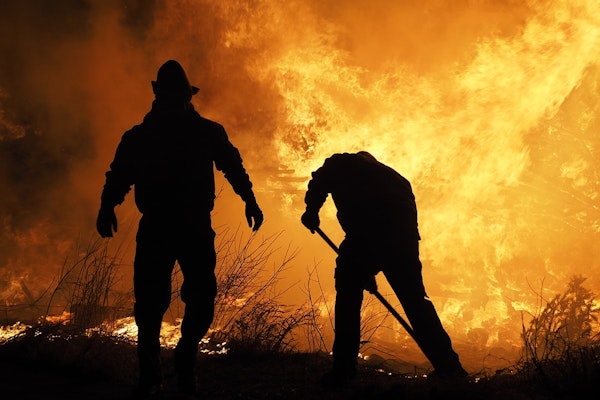
NOAA Launches First Hourly Wildfire Risk Model to Improve Forecasting and Response
NOAA’s new Hourly Wildfire Potential Index offers hourly wildfire hazard forecasts, helping responders and forecasters better track fire activity and smoke emissions in real time.
September 2
Catastrophe
Property
Risk Management
Technology

Arkansas Builder Sues Zurich Over Denied Collapse Claim on Unfinished Home
A $420,000 dispute over a collapsed Arkansas home under construction challenges Zurich’s interpretation of "collapse" coverage in commercial property policies.
September 2
Litigation
Property
Risk Management
Arkansas

Verisk Projects $152 Billion in Annual Global Property Losses from Natural Disasters
Verisk’s 2025 report reveals global insured property losses from natural catastrophes have surged to $152B annually, driven by more frequent storms and wildfires.
September 2
Catastrophe
Insurance Industry
Property
Risk Management

Why Food Companies Must Treat Recall Preparedness as a Business Essential
Food recalls can escalate into costly crises without proper planning. Learn how supply chain mapping, business continuity, and mock drills can make or break your response.
September 2
Insurance Industry
Liability
Property
Risk Management

How Warehouse Technology is Reshaping Risk Models in Insurance
Connected automation in warehouses is forcing insurers to replace outdated models with dynamic, real-time risk assessments based on sensor data and machine performance.
September 2
Property
Risk Management
Technology
Underwriting

How a $100 Billion Hurricane Could Strike the US and What Insurers Need to Know
Major U.S. metro areas are increasingly vulnerable to $100 billion hurricane losses. This KCC report shows where it’s most likely and how insurers can prepare for the next big one.
August 29
Catastrophe
Insurance Industry
Property
Risk Management
Connecticut
Florida
Louisiana
Massachusetts
New Jersey

US Cyber Insurance Premiums Decline for the First Time Since 2018
US cyber insurance premiums fell 2.3% in 2024, signaling a market shift as carriers focus on underwriting discipline and sustainable growth amid evolving cyber risks.
August 29
Insurance Industry
Risk Management
Technology
Underwriting

Smarter Repair Strategies Help Insurers Tackle Rising Commercial Property Claim Costs
Rising repair costs and labor shortages are reshaping commercial property claims, but managed repair models and pre-loss agreements offer faster, smarter solutions.
August 29
Catastrophe
Insurance Industry
Property
Risk Management
California

Southern Europe Faces Unprecedented Wildfire Risk as Climate Change Fuels More Intense Fire Seasons
This summer’s wildfires in Greece, Turkey, and Cyprus were made 10 times more likely by climate change, exposing gaps in preparedness and highlighting rising regional risks.
August 29
Catastrophe
Legislation & Regulation
Property
Risk Management

How Vertical AI Agents Are Transforming Insurance Claims Workflows
Vertical AI agents are revolutionizing complex insurance workflows like LTC adjudication and auto claims by using orchestrator-worker patterns, knowledge graphs, and real-time data.
August 29
Auto
Life & Health
Risk Management
Technology

How Insurance Would Cover a Star-Studded Wedding Like Taylor Swift and Travis Kelce’s
From high-limit liability to cyber protection and paparazzi risks, insuring a celebrity wedding like Swift and Kelce’s involves complex underwriting and custom coverage.
August 28
Catastrophe
Insurance Industry
Liability
Risk Management

Anthropic Blocks Hacker Attempts to Exploit Claude AI for Cybercrime
Anthropic has detected and blocked hacker attempts to exploit its Claude AI for cybercrime, including phishing, malware creation, and influence campaigns, the company reported.
August 28
Insurance Industry
Legislation & Regulation
Risk Management
Technology

How Insurtech Is Transforming the Homeowners Insurance Business Model
Homeowners insurance has long struggled with profitability, but new insurtech solutions like LeakBot and Ting aim to cut claims costs through proactive loss prevention.
August 28
Insurance Industry
Property
Risk Management
Technology

What the Dollar Tree Helium Tank Lawsuit Reveals About Insurance Coverage Gaps
A helium tank injury led to a legal fight between Dollar Tree and its insurer. The case shows how coverage exclusions and unclear contracts can leave businesses exposed.
August 26
Insurance Industry
Liability
Litigation
Risk Management
Connecticut

How Large Language Models Are Transforming Catastrophe Risk Modeling
Large language models are reshaping catastrophe modeling by integrating real-time unstructured data, enabling insurers to shift from reactive assessment to proactive mitigation.
August 26
Catastrophe
Property
Risk Management
Technology
California





